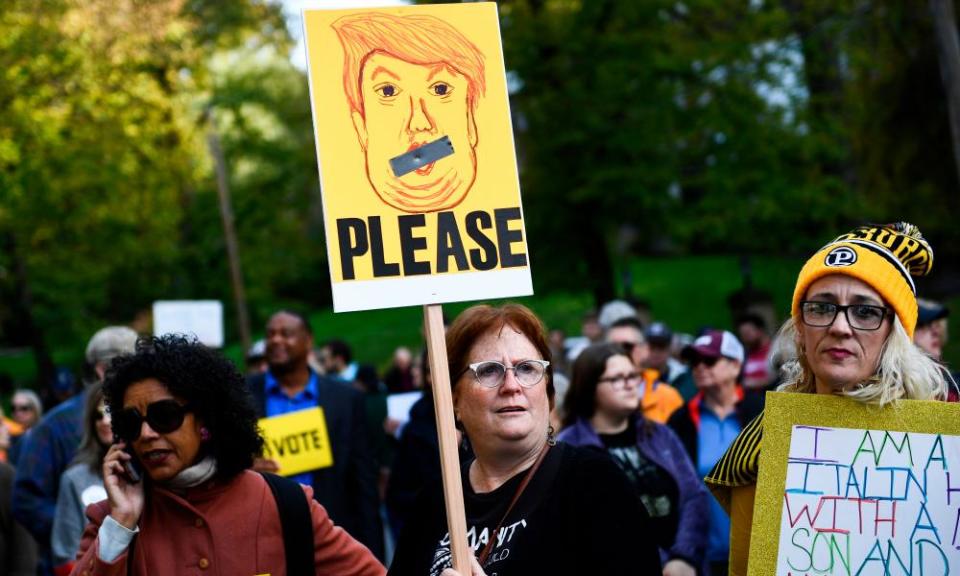First they marched, then they mobilized: how the resistance swayed the midterms
Democrats may not have generated a blue tsunami, but we saw how savvy and energized the grassroots resistance can be

The single most important player in the midterm elections may well have been the grassroots resistance to Trump. Democrats didn’t quite generate the blue tsunami they were hoping for, but they won back the House and prevailed in as many state and local elections as they did because of extraordinary and historic levels of volunteer engagement, for which the resistance can take much of the credit.
Millions of those who marched in protest since Trump took office turned their energies this fall toward mobilizing to get voters to the polls: phone-banking, text-banking, and canvassing door-to-door in record numbers, which in turn helped generate record voter turnout across the United States. An individual has only one vote to cast. But when you mobilize others to vote, you multiply your impact, and it was this multiplier effect that gave Democrats their edge in the races they won.
At moments of low morale over the last two years, many people wondered what the resistance to Trump was really accomplishing, whether all the marching and demonstrations would have any enduring impact. There have been more protests over the past two years than during any comparable period in US history, but it wasn’t always clear whether or not they were just venting frustration, shouting into the wind to compensate for a lack of other influence.
From the very start, though, the grassroots resistance to Trump has been different in important ways from previous protest movements in America. It has been unprecedented in its scale and geographic reach, kicking off with Women’s Marches in more than 650 different communities around the country that together brought more than 4 million people out into the streets. After those millions marched, they didn’t just go back home. Many of them continued to organize, forming at least 5,000 locally rooted grassroots groups around the country: a sprawling decentralized, women-led web of activists that, much like the Women’s Marches themselves, reached into every congressional district, including many places where Trump won overwhelmingly in 2016.

The grassroots resistance to Trump has also been strikingly pragmatic. Some protest movements of the past have avoided electoral involvement, seeing it as too compromised and dispiriting of an arena for action. But even where the Democratic candidates on the ballot were less than inspiring, those who had marched against Trump dug in to organizing to get them elected. Local resistance groups formed crucial nodes in a massive nationwide get-out-the-vote operation that not only dwarfed previous midterm voter-mobilization efforts but may well have been the largest in US history.
It’s worth underscoring that it wasn’t first and foremost the Democratic party itself that organized all these election-deciding volunteers. A lot of the work was coordinated by national advocacy groups like Color of Change, the Latino Victory Project, MoveOn, Indivisible, and SwingLeft, which provided ways for individuals to send texts or make phone calls to voters and connected them with campaign operations around the country. But above all, it was face-to-face interactions at the local level, often facilitated by local resistance groups, that really carried the day. Volunteers created thousands of pop-up canvassing headquarters in homes and offices around the country, and so many people installed the MiniVan app for door-to-door voter outreach that it became a top-trending download on the app store for several consecutive weekends before election day.
There were many places where the surge of get-out-the-vote mobilizing wasn’t powerful enough to offset the blunt tools of voter suppression and intimidation or the overt and toxic racism that drove so many white voters, including white women, to vote Republican, especially in the south. But the work of movements is slow and uneven; often, the impact of organizing, like the impact of protest, can’t be seen for some time. The connections that were created through all this midterm voter-mobilization work won’t go away after the pop-up campaign offices and the candidate signs come down; movements are built on relationships.
For those who dream of driving Donald Trump from office and reversing the alarming tide of authoritarianism and white supremacy, there’s hope in the fact that so much of the mobilizing that decided the midterms happened in spite of the Democratic party rather than through it. A crucial near-term task for the grassroots resistance will be holding Democrats’ feet to the fire so they act like a true counterweight to Trump rather than the pseudo-opposition they’ve so often been over the last two years. The most encouraging takeaway from the midterms is just how savvy and energized the grassroots resistance has shown itself to be. The fact that the victories were so partial is a sign not to let up: the resistance has marched and organized and mobilized on an impressive and consequential scale, and it will need to keep doing all three in order to turn things around.
LA Kauffman is a longtime grassroots organizer and movement historian. Her new book How to Read a Protest: The Art of Organizing and Resistance, has just been published by University of California Press

